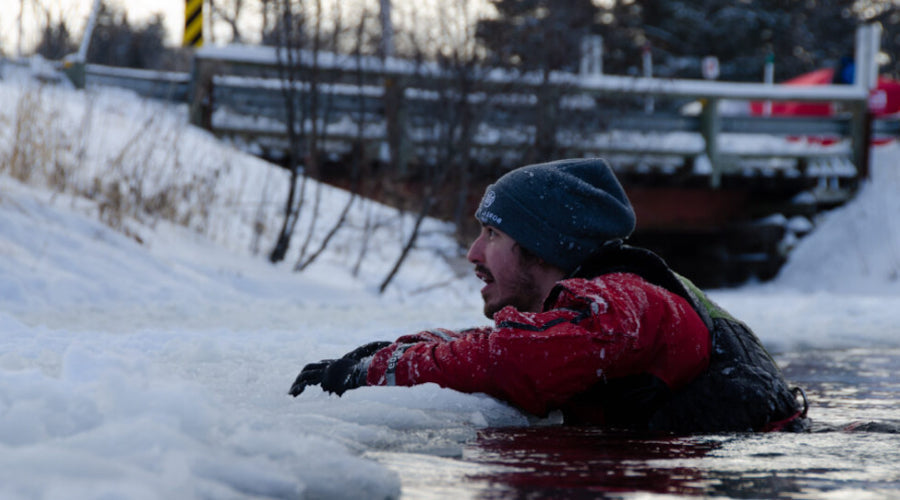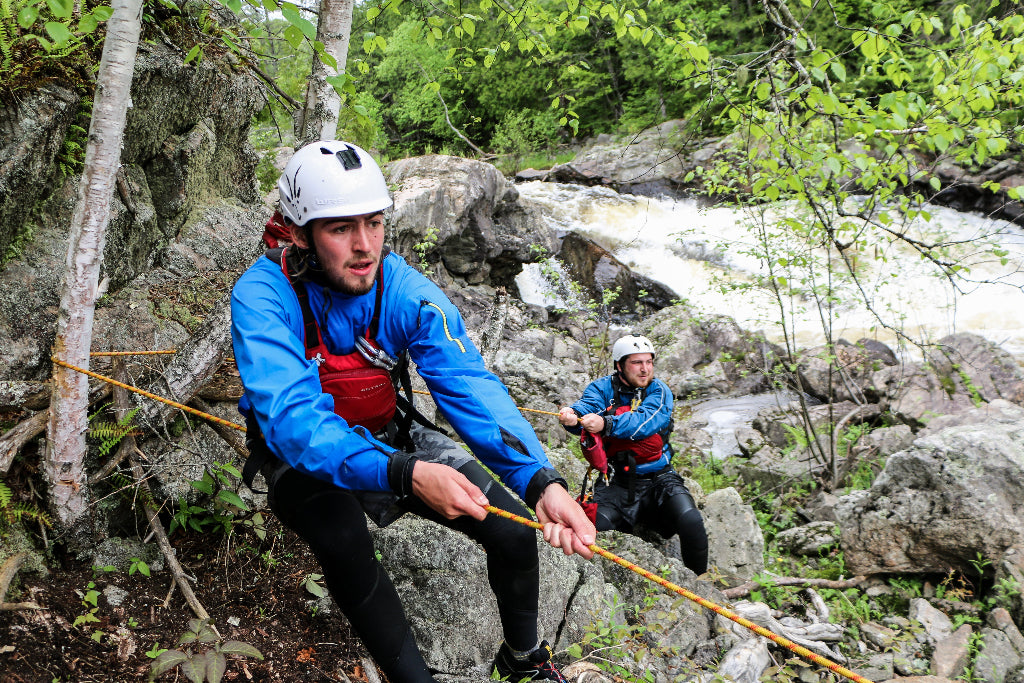Article by Alex Trainer
It doesn’t matter whether you spend a few winter weekends at a cottage, or if you are a worker who spends time near frozen lakes, knowing how to assess ice conditions and having an understanding of what to do if you fall through the ice might just save your life.
This article will provide you with the knowledge you need to survive an unexpected fall through the ice. It is important to remember that, while this is a useful guide, this is not a substitute for the instruction and hands on practice you get on an ice safety and rescue training course.

Prepare for ice travel
While the types of gear you bring will vary based on the activity or work that you are doing, there are several core pieces of equipment that are important for all ice travellers or those working in close proximity to ice.
In general, you should always:
- Prepare to stay out longer than you’re planning
- Be ready to rescue or self-rescue at any time by having the right gear accessible
- Choose submersion-ready clothing if there is a high risk of entering cold water
Also read: 6 Fundamentals to Assessing Ice Conditions
Clothing
The ideal clothing for ice rescue is waterproof, buoyant, and insulating. Some examples are a floater suit (warm, buoyant but not waterproof), survival suit (warm, waterproof and buoyant), or drysuit (waterproof only). That being said, it is not always practical or comfortable to wear waterproof clothing for long periods of time, and it could even be a safety concern since many options don’t allow temperature regulation.
Even just carrying a spare change of dry clothes in a waterproof bag would be a good idea when traveling or working near ice. A more basic kit would be a few plastic bags with a spare change of socks. This would help if you just had your feet get wet, you could change into dry socks, put them inside the plastic bags, and then put them back inside your wet boots. While this is not a perfect solution, it could get you back to your car before causing any serious damage to your feet.
Safety gear
If you are in an area with cell service, having your cell phone would allow you to call for help in any situation or emergency. If you are travelling on ice, having the phone in a waterproof sleeve or ziplock is essential.
Ice picks are a great piece of gear to aid in self-rescue on slippery ice. Commercial ice picks either have retractable guards or nesting points. They are affordable, compact, and easy to carry close at hand. You might be able to use other pieces of gear like walking sticks or ski poles to help give you leverage to pull yourself out of the water.
Another key piece of gear to carry is a whistle. This small and lightweight tool might just be the key to saving your life in the event that you need help. Two internationally recognized whistle signals are one short blast to get attention, and three long blasts to indicate an emergency.
What to do if you fall through the ice
The Phases of Cold-Water Immersion (1-10-1)
Three numbers that might save your life in the event of immersion. The reality is that you can actually survive a long period of time in cold water if you follow these guidelines. In order to do the right thing, we first need to understand what the human body goes through upon entering cold water. The 1-10-1 principle was developed by Dr. Giesbrecht (also known as Dr. Popsicle), a professor at the University of Manitoba and one of the leading researchers of cold-water physiological response. His principle states that upon entering cold water there are 3 stages the body goes through; cold shock, cold incapacitation, and hypothermia.
1 Minute – Cold Shock
Within the first minute, it is natural for panic to set in, especially when you were not anticipating entering cold water. An immediate gasp followed by hyperventilation (fast, uncontrolled breathing) means your primary concern in this 1-minute window is to gain control of your breathing and to keep your head above water.
10 Minutes – Cold Incapacitation
Following the cold shock stage, you have about 10 minutes of meaningful movement during which you’re able to swim and attempt to self-rescue. If your self rescue attempt is not successful, pull yourself up onto the ice as far as possible and stay still to conserve energy. If there may be people nearby, call for help or blow your whistle.
1 Hour – Hypothermia
Studies show after spending about 1 hour in water that is close to 0°C you will become unconscious due to hypothermia. If you can keep your airway above water with the sleeves of your jacket or your hair freezing to the ice, you may survive another hour or more before dying from hypothermia. This all depends on the amount of body fat you have, your insulation, how much of your body you can get out of the water, and the exact temperature of the water.
How to get out of the water onto the ice
Getting out of the water and onto the ice is easier than one might think. When you fall through the ice many people think that you need to pull yourself up and onto the ice. What they don’t realize is that when you break a hole through ice on a lake, water will immediately fill the hole right up to the surface of the ice. This means that in order to get out of the water and onto the ice, all you need to do is kick your legs so you are horizontal along the top of the water, and pull yourself forward onto the ice. First try to pull yourself onto the side that you had just come from. If this ice was able to support you on the way in, it is likely your best option for getting out.
Once you are out of the water and laying on your stomach, slowly roll away from the hole following the path you came from. Eventually you can switch to crawling which is easier than rolling but will still disperse your weight more than walking. Once you are confident that you are on ice that can bear your weight, you can switch to walking.
What to do after you get yourself out of the water
Once you have removed yourself from the cold water you will be completely soaked. This is where having a dry change of clothes would really come in handy but if you don’t have these with you then you should start to make your way back to a warm area like a nearby building or your vehicle. All wet clothes will need to be removed and replaced with dry ones. Finally, you will need to increase your body heat. The most effective way to do this is by eating calories and wearing insulation layers that keep your own body heat trapped inside. Below we have included a table that will help identify the severity of hypothermia and how to treat it.
Hypothermia

Ice safety links and resources
- Article: 6 fundamentals to assessing ice conditions
- Courses: Ice safety and rescue courses across Canada
If you are interested in learning more about these topics, take a look at our Online Ice Safety and Rescue Foundations Course, where we discuss topics like general ice safety principles, ice assessment, equipment, and much more.
You can also register for an Ice Rescue & Safety Certification course, which we run throughout Ontario and Canada. Here you'll get hands-on practice performing ice rescue skills, learning about equipment, and assessing real-world ice with experienced instructors.





